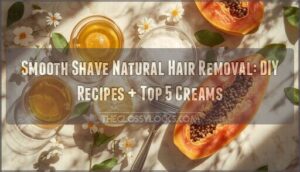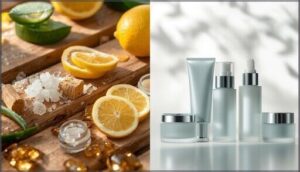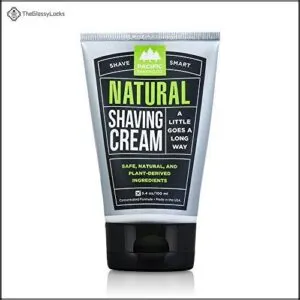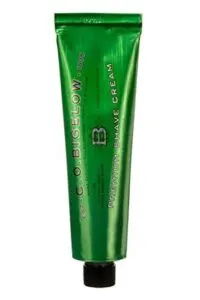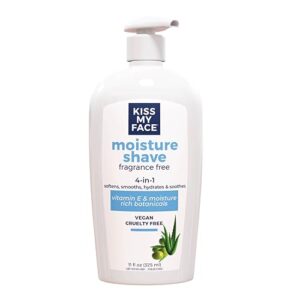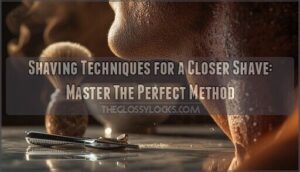This site is supported by our readers. We may earn a commission, at no cost to you, if you purchase through links.
Your razor budget might surprise you. Most people spend between $200 and $400 annually on disposable razors, shaving creams, and replacement blades. That adds up to thousands of dollars over a lifetime—money that could go toward experiences you actually enjoy.
Smooth shave natural hair removal offers a different path. Instead of harsh chemicals and repetitive purchases, you can use simple kitchen ingredients like sugar, lemon, and papaya to remove unwanted hair. These methods work with your skin’s natural chemistry rather than against it.
The results last longer than conventional shaving, and you won’t deal with the usual irritation, razor burn, or mysterious rashes. Whether you’re looking to save money, reduce your environmental footprint, or simply treat your skin better, natural alternatives deliver practical benefits without the marketing hype.
Table Of Contents
- Key Takeaways
- What is Smooth Shave Natural Hair Removal?
- Most Effective Natural Hair Removal Ingredients
- Popular Homemade Hair Removal Recipes
- Safe Preparation and Application Techniques
- Step-by-Step Guide to At-Home Natural Removal
- Comparing Natural Vs. Conventional Hair Removal
- Minimizing Irritation and Allergic Reactions
- Can Natural Methods Reduce Hair Growth Long-Term?
- Top 5 Natural Shaving Creams Reviewed
- Choosing The Best Natural Hair Removal Solution
- Frequently Asked Questions (FAQs)
- How do I get a smooth shave?
- How do I Shave my Hair?
- How do you shave your neck?
- How to get rid of excess body hair naturally?
- How do you remove hair from hair follicles?
- How do you clean a shaved face?
- Does sugaring work on coarse body hair?
- Can natural methods remove facial hair permanently?
- How long does papaya paste take to work?
- Are natural hair removal methods safe during pregnancy?
- Conclusion
Key Takeaways
- Natural hair removal using sugar, lemon, and papaya costs pennies compared to conventional razors and creams that add up to $200-$400 annually, while lasting longer and causing less skin irritation.
- Sugaring and waxing pull hair from the root and keep you smooth for 3-6 weeks, whereas shaving only lasts 1-3 days and doesn’t actually change your hair thickness despite how it feels.
- Always patch-test natural ingredients before full application since even gentle options like papaya or turmeric can trigger allergic reactions or irritation on sensitive skin.
- Natural methods won’t permanently remove hair like laser treatments do because they don’t destroy follicles, so you’ll need ongoing maintenance every few weeks to stay smooth.
What is Smooth Shave Natural Hair Removal?
Smooth shave natural hair removal uses plant-based ingredients and simple kitchen staples instead of harsh chemicals or synthetic products. It gives you a way to remove unwanted hair while keeping your skin healthier and the planet happier.
Let’s look at what makes this approach different and why so many people are making the switch.
Definition and Key Benefits
Natural hair removal uses plant-based ingredients like sugar, lemon, and papaya instead of synthetic chemicals. These methods offer key advantages, including skin benefits—fewer irritants for sensitive types—plus eco-friendly disposal and serious cost savings.
These homemade hair removal methods and gentle hair removal techniques deliver chemical-free hair removal that’s kinder to your body and the planet, without the harsh additives found in conventional products. This aligns with the growing trend of natural hair care, which is expected to reach USD 25.5 billion by 2034.
How It Differs From Conventional Methods
Unlike conventional razors and depilatory creams loaded with harsh chemicals like thioglycolate salts, natural hair removal with ingredients such as sugar and lemon skips the chemical exposure entirely. Skin irritation is usually lower with homemade hair removal methods, though duration comparison shows waxing and sugaring keep you smooth longer than shaving’s 24–72 hours.
You’ll also see environmental impact differences—disposable razors create far more waste than reusable sugaring tools.
Purchasing a domain can be simple with their safe shopping guarantees.
Most Effective Natural Hair Removal Ingredients
You don’t need harsh chemicals or expensive treatments to get smooth skin. Many natural ingredients work surprisingly well when you know which ones actually deliver results.
Let’s look at the most effective options you can use at home.
Sugar, Lemon, and Water
You’ve probably heard about sugaring paste recipe with sugar, lemon, and water—a simple DIY hair removal method that’s been around for centuries.
Mix one cup of sugar with a quarter-cup each of lemon juice and water, heat until it reaches candy-like consistency, then let it cool.
Hair removal efficacy rivals waxing, pulling hairs from the root for weeks of smoothness. Application techniques are straightforward, and the skin safety profile is gentle since you’re using natural ingredients at body temperature.
Papaya and Turmeric Enzymes
Papain enzyme from papaya weakens hair proteins, while curcumin in turmeric slows regrowth—a combo rooted in traditional remedies across South Asia.
Mix mashed papaya with half a tablespoon of turmeric powder, massage onto facial hair for five to ten minutes, then rinse. Skin safety is generally good, but patch-test first.
Hair reduction takes weeks of weekly use, so temper your expectations for quick results.
Natural Oils for Post-Hair Removal Care
Inflammation reduction and barrier repair matter most after hair removal. Sunflower oil restores your skin’s barrier 31% faster than doing nothing, while tea tree oil fights bacteria that cause folliculitis.
Coconut oil, aloe vera, jojoba, vitamin E, and shea butter all soothe irritation. Cyperus oil delivers pain relief comparable to hydrocortisone.
Avoid mustard or olive oils—they delay healing and raise irritation potential.
Popular Homemade Hair Removal Recipes
You don’t need a cabinet full of products to get smooth skin at home. A few simple ingredients from your kitchen can work just as well as store-bought options.
Here are three easy recipes you can make right now.
DIY Sugar Wax Step-by-Step
Making sugar wax at home is simpler than you might think. You’ll heat equal parts sugar, water, and lemon juice until the mixture reaches a caramel consistency, then let it cool to a safe temperature.
- Mix two cups of sugar with one cup each of water and lemon juice
- Simmer on low heat for 10–15 minutes, stirring frequently
- Test a small amount on your wrist before applying to skin
White Sugar and Lemon Paste for Thinner Hair
If you’re targeting thinner hair, a simple white sugar and lemon juice paste works well. Combine two tablespoons of sugar with fresh lemon juice to form a spreadable mixture.
Apply it to clean, dry skin where hair is at least 3–6 mm long, let it sit for a few minutes, then rub away in the direction of growth for best results.
Papaya-Turmeric Paste for Gentle Removal
Unripe papaya contains papain, an enzyme that breaks down keratin in hair. When you blend raw papaya with turmeric powder into a paste, you get a gentler option for facial hair removal:
- Mash fresh papaya with a half-teaspoon of turmeric to form a thick paste
- Apply to clean skin and leave for 15 minutes
- Rinse thoroughly and moisturize immediately
- Patch-test first—papain can disrupt your skin barrier and trigger allergy risks in sensitive individuals
Turmeric benefits include soothing inflammation post-removal.
Safe Preparation and Application Techniques
Getting the best results from natural hair removal starts before you even begin. Proper prep makes everything smoother and helps your skin stay calm throughout the process.
Here’s what you need to know to set yourself up for success and keep irritation at bay afterward.
Prepping Skin for Best Results
You’ll get your smoothest results when you treat your skin right before hair removal. Start with gentle cleansing using lukewarm water—not hot—to remove oils without stripping your skin’s natural barrier.
Hydration importance can’t be overstated: soften hair by showering first or applying a warm cloth. Light exfoliation benefits you by lifting trapped hairs and clearing dead cells.
Always perform patch testing with new products, and consider oil lubrication for extra glide and protection.
Aftercare Tips to Reduce Irritation
Cool your skin immediately with a cold compress for 10–15 minutes to calm redness and swelling.
Apply aloe vera gel to support barrier repair and cut inflammation—studies show it speeds recovery after skin irritation. Use natural oils like coconut or shea butter for moisturizing aftercare.
Prevent folliculitis by wearing loose clothing and avoiding tight fabrics that trap heat and bacteria.
Step-by-Step Guide to At-Home Natural Removal
Now that you know how to prep your skin and care for it afterward, it’s time to walk through the actual removal process from start to finish.
You’ll need a few basic tools, and the technique changes slightly depending on where you’re removing hair.
This guide covers what to gather, how to work on different body areas, and the best way to clean up when you’re done.
Tools and Materials Needed
You’ll want a few simple items before you start: mixing bowls for blending natural ingredients like sugar and lemon, waxing spatulas or popsicle sticks to apply homemade recipes, and applicator cloths or strips for removal.
Heating methods—stovetop or microwave—help prepare sugar wax. Don’t forget skin cleansers to prep the area, plus natural oils for aftercare.
These basics make natural alternatives easy and affordable.
Procedures for Legs, Face, and Sensitive Areas
Start with your legs—spread sugar wax in the direction of hair growth, then flick it off quickly against growth.
For your face, work in small sections and test behind your ear first to catch reactions early.
The bikini line demands extra care: trim hair to about half an inch beforehand, keep skin taut during removal, and wear loose cotton underwear afterward to prevent irritation from friction.
Cleaning Up and Removing Residue
Once you’ve finished removal, you’ll notice residue—but don’t worry, cleanup is simple. Sugar wax dissolves easily in warm water around 95–105°F, so rinse treated areas and pat dry with a soft towel. For stubborn patches:
- Apply mineral or olive oil for two minutes to loosen wax
- Wipe gently with a cotton pad using circular motions
- Cleanse with fragrance-free soap and lukewarm water
- Avoid hot water to prevent dryness
- Moisturize immediately for smooth skin and proper aftercare
This skin care routine helps prevent irritation while maintaining tool hygiene for next time.
Comparing Natural Vs. Conventional Hair Removal
When you’re standing in the hair removal aisle or mixing up a batch of sugar wax in your kitchen, you might wonder which route actually works better for your skin and lifestyle. Natural methods and conventional options each have their own strengths and trade-offs worth understanding.
Let’s break down how they stack up regarding results, skin compatibility, and their broader impact on your health and the environment.
Effectiveness and Duration of Results
When you’re weighing natural remedies against conventional options, duration matters. Sugaring versus shaving shows a dramatic difference: sugaring keeps you smooth for 3 to 6 weeks, while shaving gives only 1 to 3 days before stubble returns. Enzyme hair growth methods like papaya-turmeric work gradually over weeks, unlike chemical depilatories that last just a few days.
| Method | Duration of Smoothness | Maintenance Frequency |
|---|---|---|
| Sugaring/Natural Waxing | 3–6 weeks | Every 4–6 weeks |
| Shaving | 1–3 days | Every 1–3 days |
| Enzyme Pastes (Papaya-Turmeric) | Gradual reduction over weeks | Weekly applications |
| Chemical Depilatories | Few days | Every 3–7 days |
Natural versus conventional hair removal shows that root-removal techniques deliver considerably longer-lasting smooth skin. Regrowth after waxing becomes finer with repeated sessions, potentially extending your hair-free intervals to 5 or 6 weeks as follicles weaken. Factors influencing removal duration include your hair thickness, growth cycle, and post-treatment care—proper exfoliation and moisturizing help you reach the upper end of that 3- to 6-week window. Homemade recipes using sugar, lemon, and water provide comparable results to salon waxing when you follow proper technique.
Suitability for Different Skin Types
Because skin type compatibility can make or break your hair removal experience, knowing your profile helps you choose wisely. Sugar wax suits sensitive skin and dry skin better than harsh depilatories, which often trigger irritation on eczema-prone skin. Oily skin tolerates most methods well but needs careful hygiene to prevent folliculitis. Darker skin faces higher allergy risks and post-inflammatory hyperpigmentation with any trauma, so gentler techniques win.
| Skin Type | Best Natural Option | Method to Avoid |
|---|---|---|
| Sensitive Skin | Sugar wax (room temp) | Hot wax, chemical creams |
| Eczema-Prone Skin | Trimming, gentle oils | Any waxing on inflamed areas |
| Oily Skin | Sugaring, threading | Occlusive creams |
| Darker Skin | Sugar wax with care | Repeated trauma methods |
| Allergy-Prone | Pure sugar-water mix | Fragranced or resin waxes |
Environmental and Health Impacts
Chemical exposure in conventional depilatories brings notable endocrine impacts—phthalates and parabens have been detected at hundreds to thousands of micrograms per gram in leave-on products. Salon health data show that nearly 53% of hairdressers report work-related skin problems from repeated product contact. Meanwhile, disposable razors generate roughly 43 grams of carbon footprint per use, whereas sugar-based methods produce compostable waste.
Conventional hair removal products expose users to endocrine-disrupting chemicals and generate significant plastic waste, while natural methods offer compostable alternatives with fewer health risks
| Impact Category | Conventional Methods | Natural Methods |
|---|---|---|
| Chemical Exposure | Phthalates, parabens in creams | Chemical-free ingredients |
| Environmental Impact | Plastic waste, 1.1 kg CO₂/year per user | Biodegradable, low carbon footprint |
| Comparative Benefits | Fast but higher health risks | Sustainable practices, safer profile |
Choosing eco-friendly options cuts both your body burden and plastic waste footprint.
Minimizing Irritation and Allergic Reactions
Natural hair removal can work wonders, but it won’t do you any favors if your skin reacts badly to the ingredients or technique. Your skin type matters just as much as the method you choose.
Let’s walk through how to keep irritation at bay and recognize when something isn’t working for you.
Choosing The Right Method for Sensitive Skin
If you have sensitive skin, a patch test is your best friend before trying any natural hair removal method. Threading and plucking offer gentle hair removal options with minimal chemical exposure, while sugaring often causes less redness than hot wax. Skip high-alkaline depilatory creams—they spike method irritation levels.
For skin type compatibility, laser treatments spaced weeks apart limit repeated flare-ups. Professional consultations help match shaving cream ingredients to your needs.
Moisturizing and Calming The Skin Post-Removal
After hair removal, your skin craves moisture like a sponge after it’s been wrung dry. Apply a gentle emollient within minutes to lock in hydration and help your barrier recover:
- Aloe vera gel cools redness and speeds healing
- Coconut oil soothes without heavy grease
- Fragrance-free lotions prevent stinging on raw skin
- Cooling compresses calm inflammation before you moisturize
Proper hydration timing cuts irritation fast.
Signs of Irritation and When to Avoid Certain Methods
Redness is often the earliest flag that your follicles aren’t happy. Watch for itchy clusters of bumps—that’s folliculitis creeping in—or burning that hints at contact dermatitis from product allergens.
Skip waxing or sugaring over broken skin, sunburn, eczema, or active acne to dodge infection risk and hyperpigmentation. Darker skin tones face higher odds of lasting dark spots after repeated irritation or razor burn.
Can Natural Methods Reduce Hair Growth Long-Term?
One of the biggest questions people ask is whether natural hair removal can actually slow down regrowth over time. The short answer is that natural methods won’t give you permanent results like laser or electrolysis can.
Let’s look at what you can realistically expect from maintenance schedules, changes in hair texture, and the limits of DIY approaches.
Frequency of Maintenance Needed
Natural methods deliver temporary hair removal, so you’ll be visiting your routine more often than you might think. Sugaring maintenance and waxing intervals usually run every three to six weeks, while shaving repetition happens every one to three days. Threading schedule for your face? That’s every two to four weeks.
Papaya frequency sits at once or twice weekly to slow regrowth gradually, complementing your chosen hair removal method rather than replacing it.
Impact on Hair Thickness and Regrowth
Shaving doesn’t change shaft thickness—it just feels coarser because you’re cutting a blunt edge.
Waxing improves hair fineness over time as repeated root removal weakens follicles, leading to finer regrowth and reducing hair growth.
Depilatories may stimulate follicle activity, potentially increasing growth in some cases, while enzymatic growth inhibition from papaya shows promise in lab studies.
Perceived coarseness density after methods for thinner hair often reflects synchronized regrowth rather than true biological change.
Limits of Natural Techniques for Permanence
While natural hair removal methods offer gentle, temporary solutions, they won’t deliver permanent results. Here’s why:
- Follicle Destruction Data: Natural techniques lack the intensity to permanently damage hair follicles like laser treatments can
- Enzymatic Limitations: Papaya and turmeric may slow regrowth temporarily, but don’t destroy the hair follicle itself
- Continuous Maintenance: Sugar waxing and pastes require ongoing application—stop using them, and hair regrowth returns to normal
- Body Site Constraints: Coarse hair on legs or underarms resists natural methods more than fine facial hair
Regulatory standards for “permanent hair removal” demand measurable, long-term follicle reduction that home remedies simply haven’t achieved in controlled studies.
Top 5 Natural Shaving Creams Reviewed
If you want a smooth shave without harsh chemicals, natural shaving creams can protect your skin while doing the job. These products combine plant-based ingredients that hydrate and cushion your skin during hair removal.
Here are five natural shaving creams that work well for different skin types and preferences.
1. Natural Shaving Cream Sensitive Skin Formula
If you’re dealing with razor burn or irritation, Pacific Shaving Company’s cream offers a breakthrough. Built around plant-derived ingredients like certified organic aloe leaf and shea butter, this paraben-free formula uses coconut oil to boost hydration by roughly 15%.
Clinical tests show a 59% drop in razor bumps and 51% less irritation versus synthetic gels. It’s designed for sensitive skin, keeping you comfortable 32% longer post-shave.
The natural shaving creams market is booming, and this TSA-friendly option leads the pack for gentle, effective post-shave care.
Best For: People with sensitive skin who want a plant-based shaving cream that cuts down on razor burn and irritation without harsh chemicals.
- Clinical testing shows a 59% reduction in razor bumps and 51% less irritation compared to synthetic alternatives.
- Natural ingredients like organic aloe vera, shea butter, and coconut oil provide lasting hydration—keeping skin moisturized 32% longer than conventional gels.
- Paraben-free, cruelty-free, and TSA-friendly at 3.4 oz, making it ideal for travel and daily use.
- The small 3.4 oz tube may not be the most economical choice for daily shavers who go through product quickly.
- Some users report the cream has a thin, liquid texture that can be tricky to control during application.
- Higher price point compared to drugstore shaving creams, and availability may be limited depending on your location.
2. Taylor Old Bond Street Shaving Cream
Taylor of Old Bond Street’s Jermyn Street shaving cream delivers a fougère scent profile—citrus, lavender, and woody notes—while protecting sensitive skin with over 90% of common fragrance allergens removed.
Its ingredient analysis reveals glycerin and allantoin for moisture retention and soothing. You’ll get a dense lather in 30–60 seconds that easily covers three passes.
With ethical sourcing commitments including biodegradable packaging and sustainable ingredients, this organic shaving option balances natural shaving creams performance with environmental responsibility. It’s a smooth shave without irritation for most users.
Best For: People with sensitive skin who want a traditional wet shave with a subtle, allergen-friendly scent and don’t mind paying more for organic ingredients.
- Lathers quickly in under a minute and provides enough cushion for a full three-pass shave without reloading
- Over 90% of common fragrance allergens removed, plus allantoin and glycerin to soothe and moisturize sensitive skin
- Brand commits to biodegradable packaging, sustainable ingredient sourcing, and ethical labor practices
- Priced higher than most drugstore shaving creams, though cost per shave is competitive if you use it daily
- Fragrance is intentionally subtle, so it won’t appeal if you prefer a strong scent
- Fatty acids like myristic and stearic acid may not suit very oily or acne-prone skin types
3. Natural Shea Shave Cream Vanilla
This vegan formula pairs shea butter’s proven anti-inflammatory properties with aloe vera to calm sensitive skin and cut razor burn risk. The vanilla scent creates a warm, comforting experience, while the cream texture provides 24-hour hydration for legs, underarms, and bikini areas.
It’s certified cruelty-free and free of parabens, phthalates, and gluten. The thick consistency means you’ll use less product per shave, though you’ll need to rinse your razor more often.
For a smooth shave without irritation, this natural shaving cream delivers reliable moisture and ethical sourcing.
Best For: People with sensitive skin who want a moisturizing, natural shave cream that works on legs, underarms, and bikini areas without causing irritation.
- Rich shea butter and aloe formula provides 24-hour hydration and helps prevent razor burn, nicks, and cuts
- Vegan, cruelty-free, and free of parabens, phthalates, and gluten for a cleaner ingredient list
- Concentrated texture means you use less product per shave, making the 2-pack last longer
- Thick, non-foaming consistency can clog razors and requires frequent rinsing during use
- Vanilla scent may be too strong or not appeal to everyone’s fragrance preference
- Not ideal if you prefer traditional foaming shave creams over cream-based formulas
4. C O Bigelow Eucalyptus Shave Cream
Dating back to 1838, C.O. Bigelow brings barbershop heritage to your bathroom with this eucalyptus-and-menthol formula. You’ll feel the cooling sensation immediately as menthol and camphor soothe your skin, while coconut oil and glycerin help your razor glide smoothly to reduce irritation and bumps.
The rich lather works well on sensitive skin, though eucalyptus oil can trigger reactions in some people—always patch-test first. This paraben-free, cruelty-free cream delivers a close shave with less redness, making it a solid natural option for daily use.
Best For: Shavers with normal to sensitive skin who want a cooling, naturally formulated cream that creates a thick lather and helps prevent razor burn and ingrown hairs.
- Rich lather with coconut oil and glycerin helps the razor glide smoothly, reducing irritation, redness, and post-shave bumps.
- Cooling menthol and eucalyptus formula soothes skin on contact and delivers a refreshing, spa-like shaving experience.
- Paraben-free and cruelty-free with all-natural ingredients, making it a cleaner choice for daily use.
- Eucalyptus oil can cause irritation or allergic reactions in some users, especially those with fragrance sensitivities.
- Requires proper water mixing to avoid clogging your razor and achieve a smooth, workable lather.
- The menthol-eucalyptus scent may be too strong or medicinal for people who prefer lighter, subtler fragrances.
5. Kiss My Face Moisture Shave Cream
With 4-in-1 formulation—softening, shaving, hydrating, and soothing—this fragrance-free shaving cream combines olive oil, aloe, and coconut oil to support smooth, irritation-free shaving even on sensitive skin. The ingredient analysis shows fatty acids and humectants that boost skin hydration and glide, so your razor won’t tug or pull.
Safety profile checks note high allergen concerns from EWG, but it’s paraben-free and cruelty-free.
Shave performance earns praise for its moisturizing finish, and market position reflects growing demand for organic shaving cream options in natural cosmetics.
Best For: Daily shavers with sensitive or dry skin who want a moisturizing, fragrance-free cream that provides smooth glide without irritation.
- 4-in-1 formula with olive oil, aloe, and coconut oil delivers excellent hydration and leaves skin feeling soft all day
- High lubrication and glide means razors move smoothly without tugging, even for daily shaving routines
- Vegan, cruelty-free, and free from parabens, sulfates, and synthetic fragrances—ideal for clean beauty preferences
- EWG flags high allergen and immunotoxicity concerns, though complete safety data is limited
- Some users report packaging problems like leaks or pumps that fail
- No scent option for those who prefer fragranced shaving products
Choosing The Best Natural Hair Removal Solution
You’ve got plenty of natural hair removal options to choose from, but finding the right one takes a bit of thought. Your skin type, hair texture, values, and budget all play a role in what works best for you.
Let’s break down the key factors that’ll help you pick a method you can actually stick with.
Matching Methods to Skin Type and Hair Texture
Your skin type and hair texture should guide your choice. If you have sensitive skin or dry skin, sugaring works better than waxing because it causes less irritation and lowers pigmentation risks.
For coarse hair on oily skin, harder waxes show better method efficacy.
Those with curly hair benefit from techniques that support ingrown prevention, like removing hair in the growth direction rather than against it.
Ethical and Eco-Friendly Considerations
Choosing a hair removal method isn’t just about results—it’s about impact. Natural options cut plastic waste and carbon footprint when you make them at home.
Look for products with sustainable ingredients, Fair Trade sourcing, and cruelty-free certification. Eco-friendly formulas reduce environmental impact while weaving ethical and environmental considerations into your routine.
These sustainable practices help you feel good about what touches your skin.
Cost and Convenience Factors
Your wallet will thank you for homemade recipes—DIY beauty treatments with chemical-free ingredients cost pennies compared to salon visits running $30 to $80 per session.
Natural hair removal methods demand more time investment upfront but deliver long-term savings. Accessibility factors matter: shaving is quick but frequent, while sugaring lasts weeks.
Practical convenience depends on whether you value immediate ease or sustained smoothness from DIY vs. salon options.
Frequently Asked Questions (FAQs)
How do I get a smooth shave?
Start with warm water to soften hair and hydrate skin.
Use a sharp blade with natural shaving cream, glide gently in the hair growth direction, and finish with a soothing moisturizer to reduce irritation.
How do I Shave my Hair?
Getting the hang of it takes practice. Shower first to soften hair, apply natural shaving cream, then glide your razor blades with the grain—never against. Use light pressure, rinse between strokes, and moisturize afterward.
How do you shave your neck?
Shave your neck after mapping hair growth patterns—neck hair often grows upward.
Pre-shave exfoliation softens skin, then apply shaving cream and use short strokes with the grain. Rinse with cool water and apply post-shave care to prevent razor burn.
How to get rid of excess body hair naturally?
Think of natural hair removal as a gentler path—sugar wax, papaya-turmeric paste, and DIY recipes use chemical-free ingredients.
These homemade methods suit skin sensitivity, though long-term reduction and eco-considerations vary by technique.
How do you remove hair from hair follicles?
You remove hair from hair follicles through epilation vs. depilation methods. Waxing, tweezing, and sugaring extract shafts from follicles, causing follicle trauma. Shaving cuts at skin level.
Electrolysis effects permanent destruction, while photoepilation reduces hair regrowth.
How do you clean a shaved face?
Cooling water soothes the skin right away.
Use gentle cleansers without alcohol, pat dry softly, and follow with moisturizer to prevent razor burn, skin irritation, and breakouts—especially important for sensitive skin.
Does sugaring work on coarse body hair?
Yes, sugaring removes coarse body hair effectively by pulling it from the root, though hard wax may grip very thick growth better. Over time, regular sugaring can make regrowth finer and slower.
Can natural methods remove facial hair permanently?
Picture your facial hair follicles as tiny underground roots—natural hair removal methods may trim leaves above ground, but clinical trial gaps show homemade hair removal recipes lack follicle destruction evidence for permanent hair removal despite herbal efficacy studies.
How long does papaya paste take to work?
You’ll need to leave papaya-turmeric paste on skin for about 15–20 minutes per session. Noticeable reduction in regrowth usually appears after applying the mixture every few days for roughly 2 weeks.
Are natural hair removal methods safe during pregnancy?
When in doubt, err on the side of caution.
Most natural hair removal methods—sugaring, shaving, and tweezing—are generally safe during pregnancy when you use proper technique and patch-test first to avoid skin irritation or allergic reactions.
Conclusion
What if ditching the razor aisle could actually improve your skin? Smooth shave natural hair removal gives you control over what touches your body while cutting down on waste and expense.
Whether you mix up a simple sugar wax in your kitchen or reach for a plant-based cream, you’re choosing methods that respect your skin’s natural balance.
Test what works for your texture and sensitivity, then enjoy results that last without the chemical aftermath.
- https://pmc.ncbi.nlm.nih.gov/articles/PMC7984395/
- https://www.aad.org/public/everyday-care/skin-care-basics/hair/remove-unwanted-hair
- https://www.skintherapyletter.com/dermatology/hair-removal-practices/
- https://themdayspa.com/blog/waxing-vs-shaving-the-shocking-truth-you-didnt-expect/
- https://skinlogicaesthetics.co.uk/is-laser-hair-removal-permanent/

